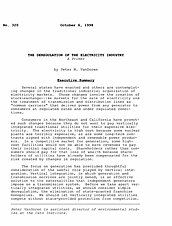Several states have enacted and others are contemplating changes in the traditional industrial organization of electricity markets. Those changes involve the creation of stock-exchange-like markets for the sale of electricity and the treatment of transmission and distribution lines as “common carriers” that deliver power from any generator to consumers at regulated rates and under regulated conditions.
Consumers in the Northeast and California have promoted such changes because they do not want to pay vertically integrated traditional utilities for their expensive electricity. The electricity is high cost because some nuclear plants are terribly expensive, as are some long-term contracts signed with independent and renewable power producers. In a competitive market for generation, some high-cost facilities would not be able to earn revenues to pay their initial capital costs. Shareholders rather than consumers should pay for that loss of wealth because shareholders of utilities have already been compensated for the risk created by changes in regulation.
The focus on generation has precluded thoughtful consideration of the useful role played by vertical integration. Vertical integration, in which generation and transmission services are jointly owned, is an effective solution to the externalities that independent generators impose on a transmission system. Before we take apart vertically integrated utilities, we should consider simple deregulation, the elimination of state-granted franchise monopolies. We should let vertically integrated utilities compete without state-provided protection from competition.

This work is licensed under a Creative Commons Attribution-NonCommercial-ShareAlike 4.0 International License.

